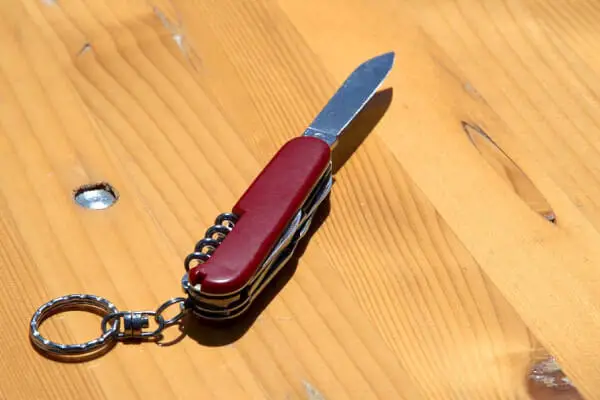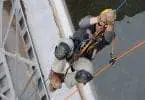Backpacking is every outdoorsman and woman’s dream come true. Nothing satisfies that need for adventure, better than a couple of days at the Nature Trail office.
Of course, no lightweight backpacker, when visiting this office, should ever be devoid of his or her basic necessities, and among them, is the decades-old, handy and versatile pocket knife.
And since this is tool is used for so many things while on the trail, it’s also important to know just how to sharpen a pocket knife.
This ergonomic tool has so many uses; from cutting ropes, slicing a piece of fruit, to saving lives and self-defense, it’s a wonder there are so many methods out there for keeping them sharpened.
See also: How to Sharpen a Knife with a Stone: The Oldest and Simplest Methods
But for the lightweight backpacker, which method is the best way to sharpen a pocket knife? In this case, let’s take a look at what a lightweight backpacker would ultimately, or periodically be using a pocket knife for.
What’s The Best Knife for The Occasion?
Of course, in lightweight backpacking, whether you’re a newbie to scaling the outdoors or an avid mountain climber, your choice of pocket knife would be based on what you’d be using your pocket knife for.
Let’s take a look at the five most common uses for a backpacking knife;
- Opening packets of food or peeling fruit
- Cutting rope or twine
- Making a spark with a fire steel
- Splitting wood, fire sticks, preparing kindling for your camp fire
- For ‘just-in-case’ life threatening situations
Sounds like real gutsy and lightweight stuff right? Well, based on these most common uses, chances are that your choice of pocket knife should be either the single folding blade or the Swiss army pocket knife. But hey, if you feel more comfortable brandishing a large, serrated blade straight out of a Rambo movie to take along on your outdoor adventure, who am I to rain on your parade?
What You Need to Know About Your Blade
No matter what method or tool you use to sharpen your single folding blade or your Swiss Army knife, if you don’t know the angles or bevel edges of your blades, then sharpening will be a daunting and tiring task, though you may be using the best method.
If you’re not an Einstein about knife angles, then you can’t go wrong with a 10 – 30 degree angle for each side of your pocket knife. Be careful, using a shallow angle will create a sharp edge that will dull out in no time. However, using a steeper angle will be more resilient to the elements that the blade is going to be used for, so between 17 – 20 degrees will be an excellent middle ground.
Most Common Tools for Sharpening A Pocket Knife
Because a dull pocket knife is a bad tool and practically useless, outdoorsmen or women need to ensure that their blades are always pristine and ready to go.
For the lightweight, sharpening a pocketknife should be easy to do, not very time consuming and effective. Some of the most common lightweight choices are;
- A Sharpening Stone* (Whetstone, Ceramic or Diamond)
- Sharpening Lubricant (mineral oil) or water*
- A Honing Rod
- The bottom of a Coffee Mug
- A Knife Sharpener (for serrated edge blades with multiple, dynamic file angles)
- Paper
*Note: Items 1 and 2 are used together in the sharpening process.
Warning: Sharpening a pocketknife can be a joy for most knife owners, but the truth is, it’s quite a dangerous task, regardless of what method you use. With that in mind, proper care should be taken when performing this ritual.
Methods of Sharpening a Pocket Knife for A Lightweight
Sharpening Stone with Lubricant – Steps to Go From Dull to Daringly Sharp
Honing Oil is best for lubricating sharpening stones. It promises to keep your blades sharp, and it works on both fine and coarse sides of the stone.
Even more beneficial, it causes zero damage. I can honestly hear you lightweights complaining about the un-necessary component of this. So, if you don’t have this oil as part of the back pack family, it’s cool, water is the next best thing, and the most economical lubricant to use.
If you want to make your pocket knife sharpening process easier, whether you decide to use Whetstone, Ceramic or Diamond Stone, simply select a stone that is around 2×6 inches.
- Lubricate your sharpening stone with either water or honing oil.
- If your blade is slightly damaged or dull, use the coarse side of the sharpening stone, then, switch to the fine grain side to achieve the sleek, razor sharp edge that you’re looking for.
- Hold your knife at a 10 to 15 degree angle, and using the right amount of force, push it against the sharpening stone away from your body. Do this about 8 – 10 times.
- You should use swift and firm strokes when using this tool, on both sides of the blade. This will ensure even distribution of treatment. After doing this on the coarse side of the sharpening stone, proceed to repeat the same steps on the fine grain side of the stone.
- Be sure to repeat these steps on the blade in the area closest to the handle. Don’t neglect this part of the knife as this is the actual part you’ll mostly be using.
A Honing Rod – The Steel ‘Pointless’ Sword
Honing Rods are also known as sharpening steel. While the rods will sharpen your pocketknife, in a sense, it should be mentioned that honing rods are actually meant to keep the pocket knife blades from going dull, in between the knife sharpening rituals.
What’s even more good news for you lightweights, is if you have a special ‘relationship’ with your pocket knife, the honing rod reduces the need to use the sharpening stone, which can actually chip away at the metal of your blades.
So if you’re looking to keep your trusty pocket mate sharp, while preserving its original blade size, then the honing rod is your tool. It’s typically used to;
- Mend small nicks and indentations
- Realign the metal of the pocket knife
- Flatten Spots
Steps:
- The Honing rod should be kept vertical at all times when using it. Take a firm grip of the handle, and ensure that it is secure on a slip free surface.
- After you have located the bevel angle of your pocket knife’s blade, you should hold the knife at a 25 – 30 degree angle.
- Swipe the pocket knife’s bevel edge along the honing rod slowly, in light strokes. Be sure not to apply too much pressure and move the blade from heel to tip continuously, until you have reached that desired sharpness.
- Repeat step 3 on the other side of your blade with as much rigor and effort as the first side. If the blade of your pocket knife is more dull than usual, you may need to put in additional elbow work with several more strokes.
The Bottom of a Coffee Mug – The Ceramic Alternative
Though it may surprise you, a coffee mug can be used to keep your trusty pocket mate nice and sharp. Let’s take a moment to examine why that is. Most coffee mugs are made with a material regularly used to sharpen the blades of pocket knives.
That material is ceramic. Sounds familiar right? So, though it may seem strange, after you have your cup of coffee just turn the mug over to brighten up your pocket knife.
It would be advisable though, to use a mug which has been in the family for a while. Though a new mug would serve the purpose just as well, the wear and tear with use of the mug would create an ideal surface to sharpen your straight edge pocket knife.
- Turn the mug over, and keeping the knife at a 20 degree angle, push it back and forth over the surface several times.
- After sharpening one side of your blade, turn the knife over to the other side, and get in the rhythm again. It’s important to remember the bevel edge of your knife and to also keep in mind, the part of the blade closest to the handle. This is the length of blade that you’ll be using more often.
Now I know, every lightweight has one of these on their back pack list. But if you don’t, you can find one at any local store near you.
A Knife Sharpener for Serrated Blades – The Modern Upgrade From a Pencil’s Best Friend
Okay, we’ve so far covered the more simple tools and methods, let’s address the other percentage of outdoorsmen and women who go for the serrated edge blades.
Some single folding pocket knives can be serrated, or a combination of both straight and serrated edge. Because of the obvious different styles of blades, there’s no way I can suggest any of the other sharpening tools already mentioned.
Nope, for this job, you have to call in the big guns! Here we have the lightweight knife sharpener for serrated blades.
- Locate which side of your pocket knife has the bevel edge, and it’s typically the one where the face of your knife’s blade angles down slightly, right before the serrated edge.
- Using one of the serrated grooves, slice the serrated side towards you with short even strokes. Do this until you have acquired the sharpened effect and look that you want.
- Since this tool can also be used for multi-blade pocket knives, for whichever size blade you’re trying to sharpen, repeat steps 1 and 2 above.
- Five or six strokes through the Tungsten Carbide V section rods will restore any nicks in your blade.
- Another three or four strokes through the Ceramic V section rods will finish your edge to a nice, fine point.
Paper – The Tester
Okay lightweights, once you’ve used any of the sharpening methods above, the next and other crucial step is testing your pocket knife, to ensure that you did an okay job. So here’s how to do this;
- Use a large enough piece of paper which is firm enough to keep its shape when holding it in one hand. Hold it up at chest height ensuring that it fits between your forefinger and thumb and use your four other fingers to keep it steady.
- With your knife hand at the ready, swiftly drive the pocket knife from top to bottom, bringing it into contact with the paper. If you did a great sharpening job, the blade should slice the paper effortlessly.
- If the paper bunches or crumples when you try to slice it, then it just means that you have to give your knife sharpening technique another go. But don’t be dismayed, just be patient and repeat the steps of the method that you had just used.
How Did You Do?
Congratulations lightweights, you’ve just learned how to take the blade of your pocket knife from blah to blindingly sharp! We’ve looked at the most simple and effective knife sharpening tools and methods, specifically for the lightweight backpackers.
Hopefully, one of these methods, depending on your patience level and energy level, will get the job done.
But just in case you’ve not gotten the gist of this article, here’s a quick recap;
- First decide on what type of pocket knife you’d be taking on your time at the ‘office’ based on what you’d be using it for.
- Next, get to know the angles and bevel edges of the blade of your selected pocket knife, to ensure the right technique is applied when sharpening.
- Then, decide on which sharpening method would be less time consuming, easy to do and more effective for you, based on the tools required, and the simplicity of the steps involved.
A Few Things to Remember
- Don’t hold me hostage if you find that one of these methods don’t work for you. It just means that you either didn’t follow the instructions carefully, or you need to try another one that works best for you.
- If you want to try out any of these methods, it would be best not to go looking for the dullest knife in your stash to practice on. If you don’t mind building extra muscle, then go right ahead. But if you’re genuinely looking to test out these methods on your trusty pocket mate, then please choose one method and follow through until you succeed.
- As a lightweight, you’re going to be looking to pack the most convenient sharpening tool with the least amount of bulkiness. So it would be a good idea to assess how much space you can cater in your backpack and if there’s enough room, then splurge away and take your pick.
- Pace yourself. Don’t go huffing and puffing away at your blade. This is your baby, so take your time to service it well.
- Get to know your angles and edges. These 2 little factors will make a ton of difference in the effectiveness of your knife sharpening technique.
Give Us Your Feedback
Hey lightweights, it’s time to weigh in. Do you have any tips and suggestions on sharpening a knife?
How about a good knife to use? We want to hear about it.
For more tips on how to choose the best fixed blade knife, see our article on this to find out.









